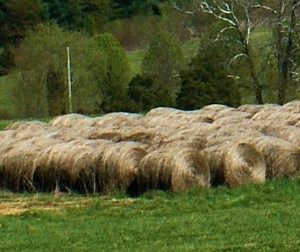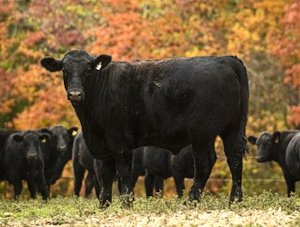 Most farmers try rotational grazing because of the economic savings. Grazers averaged about $200 more per cow net farm income than confinement dairy farms according to farm financial data collected from 1995 to 1999 according to University of Wisconsin Center for Dairy Profitability. During the same period, grazers averaged more than $1.50 higher net farm income per hundred weight equivalent of milk sold than achieved by confinement dairies. Beef, sheep, and dairy heifer growing operations have also seen reduced costs and increased profit from rotational grazing systems. Both start-up and maintenance cost are less for grazing compared to confinement systems. The only capital cost specific to rotational grazing is fencing. Costs for new fencing range from $1.18 per acre for mobile electric fencing with fiberglass posts to $18.37 per acre for high-tensile electric fencing. Setting up the whole system (using new fencing, fencers, and water systems) costs from $30 to $70 per acre. The higher price range includes the cost of constructing some livestock lanes. If you haven’t already invested in confinement feeding systems, this represents a tremendous savings; if you have, maintenance costs are reduced since your confinement system needs to be operated only
Most farmers try rotational grazing because of the economic savings. Grazers averaged about $200 more per cow net farm income than confinement dairy farms according to farm financial data collected from 1995 to 1999 according to University of Wisconsin Center for Dairy Profitability. During the same period, grazers averaged more than $1.50 higher net farm income per hundred weight equivalent of milk sold than achieved by confinement dairies. Beef, sheep, and dairy heifer growing operations have also seen reduced costs and increased profit from rotational grazing systems. Both start-up and maintenance cost are less for grazing compared to confinement systems. The only capital cost specific to rotational grazing is fencing. Costs for new fencing range from $1.18 per acre for mobile electric fencing with fiberglass posts to $18.37 per acre for high-tensile electric fencing. Setting up the whole system (using new fencing, fencers, and water systems) costs from $30 to $70 per acre. The higher price range includes the cost of constructing some livestock lanes. If you haven’t already invested in confinement feeding systems, this represents a tremendous savings; if you have, maintenance costs are reduced since your confinement system needs to be operated only during the cold months. Once in operation, grazing will reduce equipment, fertilizer, pesticide, and labor costs. Because grazing operations can be less capital intensive they can also be more financially flexible.
during the cold months. Once in operation, grazing will reduce equipment, fertilizer, pesticide, and labor costs. Because grazing operations can be less capital intensive they can also be more financially flexible.
Many farmers are reluctant to try rotational grazing because of the time they assume it will take to move livestock. However, the time to move cattle is minimal if paddock and fencing design is efficient and cattle are moved after a milking, often averaging only 15 minutes per day. In contrast, feeding hay and silage in a confinement system may take 20 minutes to 1 hour. Grazing may also decrease your need to make hay which takes an average of 7 hours per acre each season. It also reduces the need to haul manure because most manure is dropped by the cattle on the pasture. What if you have to move a huge herd? A large-scale stocker farmer prefers to move 250 to 500 head at a time since he has found that it takes no more time to move large groups of cattle than it does to move small groups (such as 50 or less).
 Well-managed perennial pastures have several environmental advantages over tilled land: they dramatically decrease soil erosion potential, require minimal pesticides and fertilizers, and decrease the amount of barnyard runoff. Data from the USDA Natural Resources Conservation Service (NRCS) shows that in 1997, an average of 3.3 tons of soil per acre were lost each year due to sheet and rill erosion on Wisconsin cropland. In Minnesota an average of 2.1 tons of soil per acre were lost each year on cropland due to sheet and rill erosion and 5.8 tons of soil per acre per year from wind erosion. Converting erosion-prone land to pasture is a good way to minimize this loss since Wisconsin and Minnesota’s perennial pastures havenan average soil loss of only 0.5 tons per acre per year from water erosion and less than 0.1 tons per acre annually from wind erosion. Reducing erosion rates will preserve the most fertile soil with higher water holding capacity for future crop production. Pasturing helps water quality in several ways. High levels of nitrates and pesticides in our ground and surface waters can cause human, live- stock, and wildlife health problems. Pasturing reduces the amount of nitrates and pesticides leaching into our groundwater in two ways: less is applied and the deeper forage root systems take up nutrients from greater depths. Pasturing also reduces contamination of streams and lakes. Nutrients contained in surface runoff enrich waters of lakes and streams with nitrogen and phosphorous which promotes excessive aquatic plant growth (leading to low oxygen levels in the water which suffocates most water life).
Well-managed perennial pastures have several environmental advantages over tilled land: they dramatically decrease soil erosion potential, require minimal pesticides and fertilizers, and decrease the amount of barnyard runoff. Data from the USDA Natural Resources Conservation Service (NRCS) shows that in 1997, an average of 3.3 tons of soil per acre were lost each year due to sheet and rill erosion on Wisconsin cropland. In Minnesota an average of 2.1 tons of soil per acre were lost each year on cropland due to sheet and rill erosion and 5.8 tons of soil per acre per year from wind erosion. Converting erosion-prone land to pasture is a good way to minimize this loss since Wisconsin and Minnesota’s perennial pastures havenan average soil loss of only 0.5 tons per acre per year from water erosion and less than 0.1 tons per acre annually from wind erosion. Reducing erosion rates will preserve the most fertile soil with higher water holding capacity for future crop production. Pasturing helps water quality in several ways. High levels of nitrates and pesticides in our ground and surface waters can cause human, live- stock, and wildlife health problems. Pasturing reduces the amount of nitrates and pesticides leaching into our groundwater in two ways: less is applied and the deeper forage root systems take up nutrients from greater depths. Pasturing also reduces contamination of streams and lakes. Nutrients contained in surface runoff enrich waters of lakes and streams with nitrogen and phosphorous which promotes excessive aquatic plant growth (leading to low oxygen levels in the water which suffocates most water life).  Pastures have reduced runoff compared to cropped fields and, since cattle spend less time in the barnyard, less manure is deposited there and barnyard runoff is reduced.
Pastures have reduced runoff compared to cropped fields and, since cattle spend less time in the barnyard, less manure is deposited there and barnyard runoff is reduced.
Populations of native grassland birds, such as upland sandpipers, bobolinks, and meadowlarks, have declined significantly within the past 50 years. These birds once thrived in the extensive native prairies that covered the state. As the land was converted to row crops and frequently mowed hay fields, the birds’ habitat has dwindled and their populations are now at risk. Many aspects of rotational grazing systems can help reverse this decline: the rested paddocks provide undisturbed nesting habitat; leaving at least 4 inches of growth in cool-season grass pastures during the spring provides needed cover for the nests; and creating large blocks (50 or more acres) that are not grazed or harvested between mid-May and early July give many young birds time to mature. Also, warm-season grass paddocks, which aren’t grazed until late June, provide especially good nesting habitat. Game birds, such as pheasants, wild turkey, and quail also benefit from pastures, as do bluebirds whose favorite nesting sites are fence posts. For more details about setting up a bird-friendly grazing system, see Wisconsin Extension publication Grassland Birds: Fostering Habitats Using Rotational Grazing (A3715) Pesticides can be very damaging to wildlife. Examples include some insecticides that are toxic to birds and mammals (including humans) and broad-spectrum insecticides that kill the target pest as well as beneficial insects that could help prevent future pest outbreaks.  Insecticides in surface waters may kill aquatic invertebrates (food for fish, shorebirds, and waterfowl). Herbicides can also be toxic to animals and may stunt or kill non-target vegetation, which may serve as wildlife habitat. The reduced need for pesticides in rotational grazing systems benefits all.
Insecticides in surface waters may kill aquatic invertebrates (food for fish, shorebirds, and waterfowl). Herbicides can also be toxic to animals and may stunt or kill non-target vegetation, which may serve as wildlife habitat. The reduced need for pesticides in rotational grazing systems benefits all.
Rotational grazing can help improve long-term pasture quality and fertility by favoring desirable pasture species and allowing for even manure distribution. Rotational grazing also can increase the amount of forage harvested per acre over continuous grazing by as much as 2 tons dry matter per acre. Aesthetics and human health benefits One of the greatest advantages to using rotational grazing is that it is a “peaceful way of farming.” It is quieter than mechanically harvesting your feed and it gives you the excuse to stretch your legs and take a look at what’s happening in your pasture. You might even hear the birds singing or see a deer grazing as you move the fence.

Animals in grazing systems are often healthier than animals housed in confinement. Animals have more space and fresh air, reducing their exposure to high levels of microorganisms. Increased freedom for movement enhances physical fitness and decreases opportunity for injuries and abrasions. However, risks associated with exposure to severe weather or predators may be increased in grazing. Many have reported fewer herd health problems after switching to grazing. For many graziers, culling animals for health reasons has dropped from about 35% of the herd annually to approximately 10%. A healthier herd is more profitable and it allows the option of increasing herd size or improving the herd by select- ing animals based on higher milk production or reproducibility.
« Read More of This Publication »